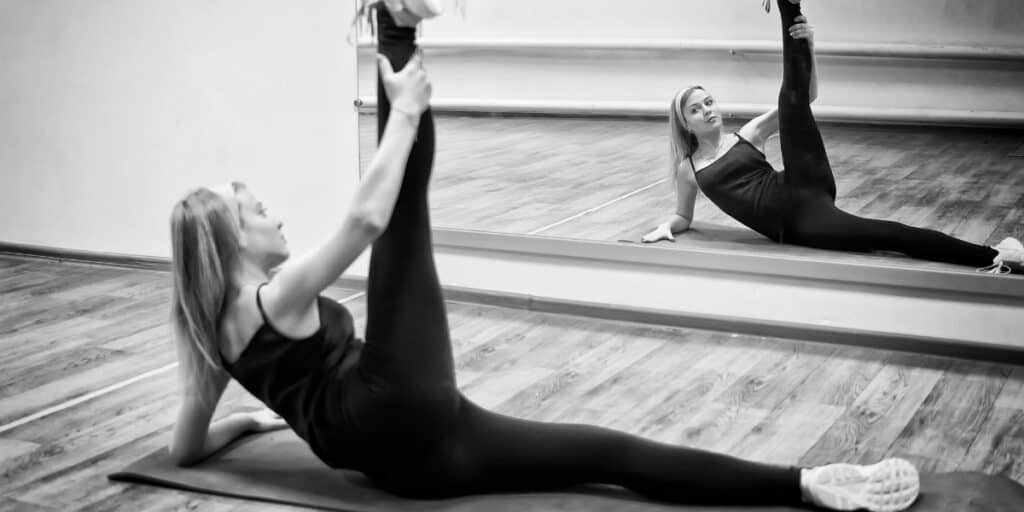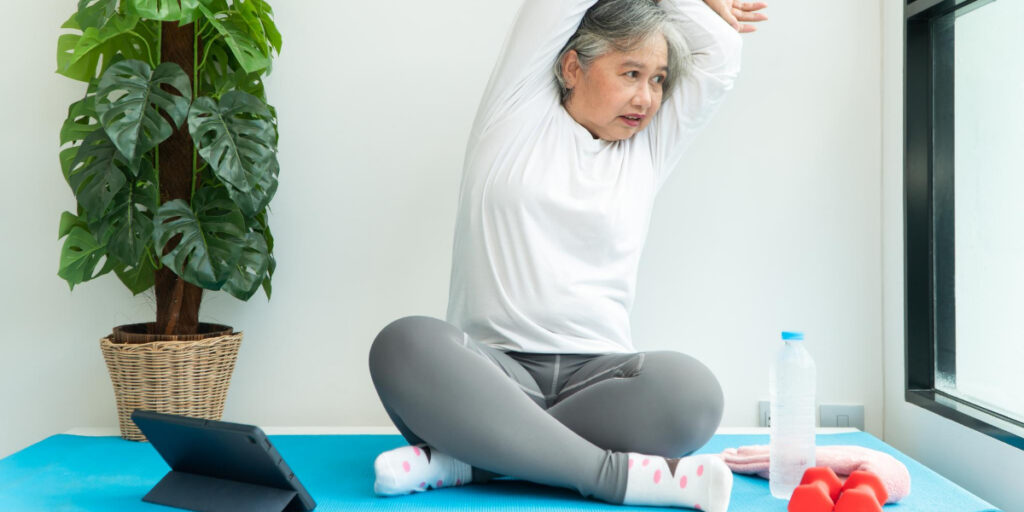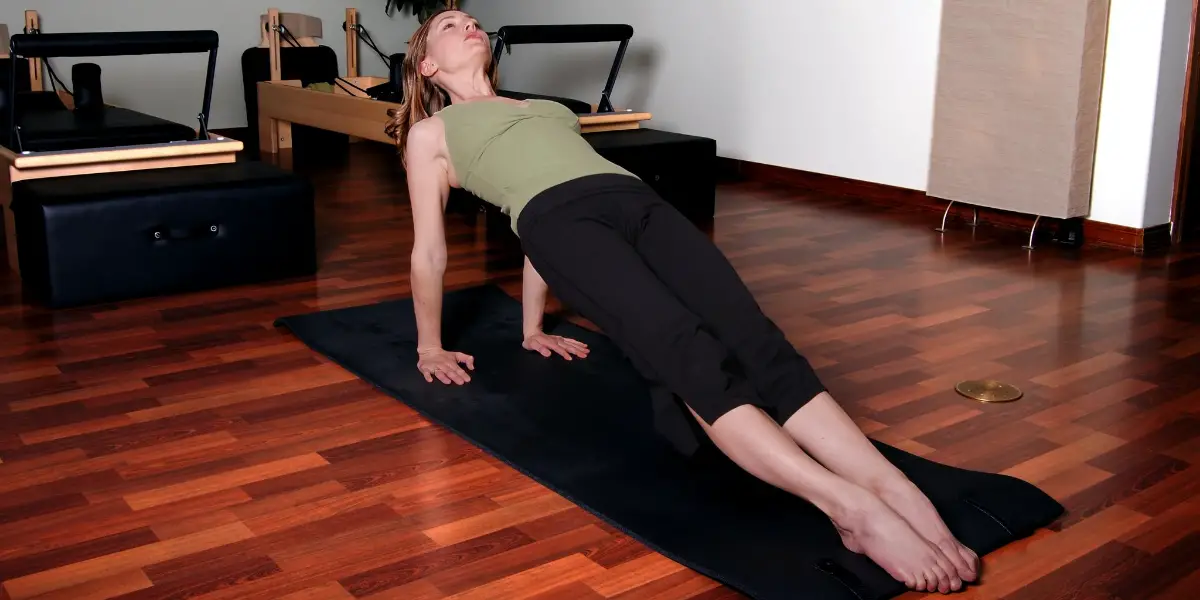In what has arguably become a global movement, more and more people are embracing different approaches to staying healthy for longer, spanning from more health-conscious eating habits to a more positive attitude towards exercise. One of the most popular approaches to strengthening your body is Pilates. But how can Pilates change your body?
Performing Pilates exercises significantly increases your body’s muscular development, flexibility, muscle endurance, and posture. These exercises also enhance your metabolic rate, help reduce body weight, and improve cardiovascular health.
In this article, I will discuss the various ways that taking on Pilates can change your body. I will also discuss the impact that Pilates has on crucial aspects of your body, including flexibility, strength, balance, weight loss, among others. If you are looking to stay fit and healthy for longer, I recommend reading on.
How Pilates Will Change Your Body
You would be forgiven for worrying that Pilates will only have a minimal impact on your body, especially when compared to other exercise routines such as weight lifting, running, and so on.
Many people believe that Pilates exercises are only suitable for old ladies, mainly because some studies and news articles over the last decade have focused on its benefits for older women.
And while it’s true that my own classes and clients are predominantly women, this view that it’s for women only could not be further from the truth. Pilates exercises are lauded not only for helping you develop a strong core but for their impact on the entire body, and because they can be performed safely by people of virtually all ages and fitness levels with minimal risks of muscle injury.
Whether you are an elite athlete, an intermediate trainer, or a complete beginner, Pilates is an excellent way to build strength.
Let’s look at some of the ways that Pilates can change your body.
Strength Development
Pilates is an excellent way to increase your strength. In their study on the effects of Pilates on muscle strength, researchers Mrunal Kulkarni and colleagues observed that this exercise format has a positive impact on core muscle strength.
The randomized study focussed on post-delivery women and was conducted over a six-month period. The results indicate that Pilates mat exercises contribute to an increase in strength. A similar study by Amorim et al. on the potential benefits of Pilates on dancers revealed similar results, showing that Pilates has a significant impact on muscular strength.

In fact, as Suna and Isildak note, the Pilates idea design as developed by Joseph Pilates was primarily aimed at strengthening the body, alongside other secondary aims such as improving flexibility and helping to correct bad posture. I will go into details on these other benefits for your body shortly.
Keeping this in mind, Pilates is a well-researched exercise program for building your body strength, and especially core strength.
Promotes Muscular Development
Doing Pilates is also an excellent approach for promoting balanced muscular development, which can significantly enhance your physical appearance and your self-esteem. Researcher Nica Irene-Teodora explains that Pilates as an exercise is highly complex and can target virtually all muscles in the body for balanced physical development.
In her study, Nica Irene-Teodora notes that regular Pilates exercises can help you achieve a toned body that is well-balanced while also improving your balance, posture, and mobility. Additionally, you do not have to worry about muscular imbalances associated with other approaches, such as weight lifting, as this approach targets and activates muscles in your entire body.
This balanced development is one of the main reasons why this exercise routine is often recommended for people looking for overall body fitness, such as ageing adults.
When I made Pilates a regular part of my everyday life, I discovered my own muscle tone changing, I became stronger and gained defined, toned muscles.
Pilates Enhance Flexibility
Pilates stretches have been known to improve flexibility. As explained by Saga, unlike other exercise options that rely on static movements, Pilates exercises focus on stretching. This has a positive impact on improving flexibility while also helping minimize muscle tension.
The impacts of Pilates on body flexibility are anchored on a broad body of literature. In the aforementioned study by Suna and Isildak, over eight weeks, the researcher found that people who performed Pilates exercises were significantly more flexible when compared to those that did not.
An interesting aspect of this study is that the study participants only performed Pilates exercises for one hour per day, three days a week over 12 weeks, to observe significant improvements in flexibility. The exercises can significantly make your body more flexible and do not require a considerable time investment.
For elite athletes looking to enhance flexibility in vulnerable areas such as hamstrings, Pilates exercises can come in handy, as highlighted by Gonzalez-Galvez and her colleagues’ study. Here is a routine to get you started.
Builds Endurance
If you want to enhance your muscle endurance, then Pilates exercises are definitely an option you should consider. As discussed by Kloubec, performing low-intensity Pilates exercises has a positive impact on muscular endurance, especially for muscles in your upper body.
According to Kloubec, you only need to perform low-intensity Pilates exercises, which are relatively easy for most people, and which do not require advanced skills or equipment. You can even include these exercises as part of your existing personal fitness routine to realize these benefits.
But why should you want to build your muscular endurance? Increased medical insurance is essential for athletes in endurance-based sports to improve their performance. Muscular endurance is also beneficial because it enhances your ability to perform daily functional routines, like lifting heavy objects, with minimal risk of injury.
Helps Improve Body Stability
In addition to boosting core stability, as previously explained, Pilates also promotes lumbo-pelvic stability. In an article published in the Asian Journal of Sports Medicine, the researchers found that performing Pilates exercises can significantly improve the control-mobility of the pelvic and trunk movements, optimizing stability.
In similar studies conducted on elderly people, Pilates is associated with a reduced risk of falls due to increased postural stability. Researcher Sinem Suner-Keklik and colleagues back this up, asserting that one of the primary goals for Pilates training is to improve your overall body stability by strengthening the core muscles.
It also promotes a neutral spine position (as will further be discussed below) and results in co-contraction in the core muscles. As a result, you are likely to experience a greater degree of mechanical stability, particularly in your vertebrae.
Including Pilates exercises in your exercise program is, therefore, a valuable solution to not only boosting strength and flexibility but also strengthening your pelvic region and enhancing trunk control-mobility for better stability. Phrompaet and his colleagues also explain that this also reduces your risk of axial musculoskeletal injuries.
Balance disorders are a common problem, especially as you grow older. To reduce the risks of falling while also building strength, I recommend adding Pilates to your workout program.
Aids in Posture Correction
In addition to strengthening your core muscles and stabilizing your upper body, Pilates can also correct your posture. According to Suna and Isildak, Pilates exercises–when used in tandem with equipment–influence posture correction in two main ways.
First, these exercises balance movements and positions that help improve your entire body. Secondly, Pilates places emphasis on your internal muscular system, targeting the deeper layers of your muscles to correct your position.
For best results, the researchers recommend pairing the exercises with other equipment such as pullets, stretch equipment with varying resistance levels, and different gravity-driven equipment.
Pilates exercises also help correct your posture by reducing pelvic tilt and enhancing spine stability. Additionally, they help improve your body awareness of the correct posture by minimizing back pain and increasing bone density, which serve to strengthen or correct your posture.
Helps Reduce Body Weight for Obese or Overweight People
I always tell clients that setting weight loss as a goal isn’t the right way to approach exercise, instead you should focus on creating a healthy lifestyle which will result in a loss of excess weight and gaining of muscles.
Pilates has a positive impact on reducing your body fat ratio. This means that if you are looking to reduce your body fat and lose some weight in the process, performing Pilates exercises is an ideal intervention.
In a study published in the Journal of Exercise Nutrition & Biochemistry, researchers Hyo-Jin Kim, Jiyeon Kim, and Chang-Sun Kim observed that performing Pilates exercises for only 60 to 70 minutes, 3 days a week, over an eight-week period can have a significant impact on body composition, especially on lipid metabolism and body fat ratio.
These exercises also positively impact your body’s high-density lipoprotein (good cholesterol), which helps in absorbing cholesterol. As reiterated by the Centers for Disease Control and Prevention (CDC), this will not only help you to lose weight, but it will also significantly reduce your risk of vital cholesterol-related health complications such as stroke and heart diseases.
If you’re just getting started check out The Essential Pilates Guide For Overweight People.
Increases Your Joints’ Range of Motion
The stretching associated with Pilates exercise can significantly increase your joint’s range of motion. The above is backed by numerous scientific studies, including a study by Nigerian researchers on patients suffering from knee osteoarthritis that revealed that these exercises help in pain reduction while also improving these patients’ range of motion.
The above conclusion is also consistent with results observed by researchers from Tennessee State University, whose study on the relationship between Pilates and range of motion in older adults shows similar results. Loss of range of motion or restriction of movement are common issues affecting many people in the United States, and especially ageing adults.

Reduced range of motion is, however, not exclusively limited to older adults. Without adequate stretching, you risk reducing your joints’ range of motion as well because your muscles tend to tighten and shorten. This can also result in injury, as your muscles will not be able to handle full extension.
However, doing Pilates can help in improving your joints’ mobility while also mitigating associated risks.
How Pilates Can Improve Your Body’s Functioning
When it comes to how Pilates can affect the body, it is essential to remember that, like most effective exercise approaches, it can boost your body’s functioning by promoting better organ health and functions.
After all, Pilates is a full body workout and therefore has numerous benefits related to muscular development, such as strength, flexibility, and other factors already discussed, as well as a healthy body and organs.
So how does Pilates improve how your body functions? Let’s take a look at some of these benefits below.
Improved Metabolic Rate
Performing Pilates exercises will also boost your metabolic rate. This is because Pilates exercises stimulate your body’s organs and systems. This, in turn, helps your body get rid of toxins while also enhancing blood circulation in your body.
A higher metabolic rate also helps you to lose weight and prevent regaining weight. It has been linked with better sleep and generally more energy.
Blood Pressure Reduction
Pilates workouts can also help reduce blood pressure, especially for hypertensive people. In a study by Brazilian researchers, Gonzales and her colleagues explain that Pilates exercises have wide applications in the rehabilitation of hypertensive patients due to their association with blood pressure reduction.
In a similar study conducted on hypersensitive women published in the International Journal of Cardiology, the researchers determined that mat training has a blood-pressure reduction effect. Therefore, it should come to no one’s surprise that Pilates exercises are recommended for hypertensive patients looking to improve their cardiovascular health without compromising their responses to hypersensitive medication.
Pilates exercises have also been linked to blood pressure reduction among young people with obesity at a high risk of weak blood vessels and high blood pressure. According to Dr. Liji Thomas from News Medical Life Sciences, people who perform Pilates exercises tend to have lower blood pressure and lower arterial stiffness.
Therefore, in addition to reducing blood pressure for people at risk of hypertension or with hypertension, Pilates exercises also help to prevent hypertension among young people with obesity and cardiovascular problems associated with hypertension.
They are also ideal for reducing risk of hypertension among sedentary individuals. In a study on how Pilates affects blood pressure, the researchers determined that an hour of Pilates exercises a day for three days a week will have a positive impact on reducing your blood pressure.
By improving your cardiovascular health and lowering your heat pressure, these exercises can, therefore, significantly reduce your risk of vascular and heart disease, especially when combined with other aerobic exercises.
Improves Your Heart Rate
Suna and Isildak’s study on the effects of Pilates on body composition found that these exercises can reduce your resting heart rate. As explained by the Mayo Clinic, your normal heart rate should range from 60 to 100 beats per minute. Therefore, a lower heart rate is usually an indication that your heart is functioning efficiently and that you are of good cardiovascular health.
Like in the case of high blood pressure discussed above, a high resting heart rate increases your risk of cardiovascular diseases such as cardiac arrest, stroke, and heart failure. It is therefore advisable to keep your resting heart rate as low as possible.
The study by Suna and Isidak reveals that individuals who undertake Pilates exercises tend to have a lower resting heart rate as opposed to those who do not. This shows the impacts that these exercises–even when done only several days a week–can have on improving your cardiovascular health.
Reduction of Body Glucose Levels
Performing Pilates exercises regularly also reduces your blood glucose level. As reiterated by the physical fitness experts at Be Fit, most doctors and physicians recommend these exercises to help reduce your blood sugar levels, which, in turn, helps prevent diabetes.
While most exercise regimens will have a positive impact on blood glucose level management, Pilates exercises and stretches are relatively easier to do whether you are a beginner or an advanced athlete. At the same time, these exercises have a much lower risk of muscular or joint injuries.
According to advice from physical trainers at Be Fit, doing Pilates just for eight weeks will significantly improve your general health, reduce disease symptoms, reduce anxiety and depression symptoms if you have Type 2 diabetes.
Whether you have Type 2 diabetes or not, doing Pilates is highly recommended to keep your blood glucose levels low, while also protecting yourself from blood glucose-related health complications.
Conclusion
Doing Pilates regularly has significant impacts on your body. These exercises can help promote muscular development for improved strength while also enhancing your degree of flexibility, muscular endurance, core stability, and cardiovascular functioning.
These exercises have also been linked with numerous health benefits, such as reducing bad cholesterol that promotes obesity, reducing glucose levels for better diabetes management, reducing risk of injury, and reducing risk of cardiovascular-related events such as heart attacks and strokes.
In addition, clients who incorporate a Pilates practice into their lives have reported back to me that it has had a beneficial impact on their mental health and energy levels, improving their overall quality of life.
Sources
- National Library of Medicine: Integrating Pilates Exercise Into an All Exercise Program For 65+ Year-Old Women to Reduce Falls
- Reuters: Pilates Linked to Better Balance in Older Women with Back Pain
- ResearchGate: Effects of Pilates on Core Muscle Strength And Endurance in Post 6 Months Delivered Women
- ResearchGate: Influence of Pilates Training on Muscular Strength and Flexibility in Dancers
- Institute of Education Sciences: Investigation of the Effect of 8-Week Reformer Pilates Exercise on Flexibility, Heart Rate and Glucose Levels in Sedentary Women
- Saga Magazine: Key Health Benefits of Pilates
- ResearchGate: The Effects of Pilates Method in Scholar’s Trunk Strength and Hamstring Flexibility: Gender Differences
- ResearchGate: Pilates for Improvement of Muscle Endurance, Flexibility, Balance and Posture
- Medical News Today: The best way to train to improve muscular endurance
- Body+Soul: Boost your Metabolism with Pilates
- Centers for Disease Control and Prevention: LDL and HDL Cholesterol: “Bad” and “Good” Cholesterol
- National Library of Medicine: The Effects of Pilates on Lipid Metabolism and Inflammatory Cytokines mRNA Expression in Female Undergraduates
- Beebe Healthcare: Boost Your Metabolism For Better Health
- ResearchGate: Effects of Pilates Training on Lumbo-Pelvic Stability and Flexibility
- Springer: An Online Pilates Exercise Program is Effective on Proprioception and Core Muscle Endurance in a Randomized Controlled Trial
- National Library of Medicine: Effects of Pilates Training on Lumbo-Pelvic Stability and Flexibility
- National Library of Medicine: Pilates Reducing Falls Risk Factors in Healthy Older Adults: A Systematic Review and Meta-Analysis
- ResearchGate: Pilates Exercises for Hypertensive Patients: A Review of the Literature
- ResearchGate: Mat Pilates Training Reduced Clinical and Ambulatory Blood Pressure in Hypertensive Women Using Antihypersensitive Medications
- Scientific Electronic Library Online Brazil: Subacute effects of the number of Pilates exercise series on cardiovascular responses in hypertensive women
- News Medical Life Sciences: Pilates Helps Control Blood Pressure in Young Obese Women
- RedFame: The Effects of Pilates and Aerobic Exercise on Blood Pressure, Heart Rates, and Blood Serum Lipids in Sedentary Females
- Mayo Clinic: What’s a normal resting heart rate?
- Be Fit Physical Therapy & Pilates: The Effect of Pilates on Diabetes
- ResearchGate: Comparative Effects of Pilates and Isometric Exercises on Pain, Functional Disability and Range of Motion in Patients with Knee Osteoarthritis
- WorldWide Journals: The Effects of Pilates on Range of Motion in Aging Adults Living in Assisted Living Facilities
- ResearchGate: The Role of The Pilates Method in the Formation and Development of Body Balance




